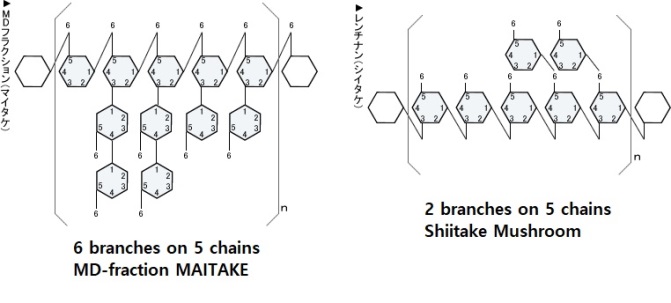
|
|
| What is "MD-fraction," the Maitake Extract?
MD-Fraction was discovered during a research conducted by Emeritus Professor Nanba of Kobe Pharmaceutical University in 1985. A total of 36 types of domestic and foreign mushrooms were examined for the potential anticancer effects of their polysaccharide, and maitake showed the strongest effect. The polysaccharide of maitake was refined into several fractions named A, B, C, and D, in order of their extraction. The last obtained "D-Fraction" showed powerful antitumor properties. This extraction was named "MD-fraction," with the M standing for maitake. This MD-fraction has a special molecular structure that is not found in other types of mushrooms and is considered to demonstrate stronger immune effects than other mushrooms.Some potential health benefits of MD-fraction related to the immune system include inhibition of cancer growth and metastasis, disease prevention and maintenance of good health. difference in chemical structure  What is "MX-fraction, Maitake polysaccharides contain components other than the MD fraction. One of them, the MX fraction, was also discovered and named by Professor Emeritus Namba. It was announced in 1999. that it is particularly effective for lifestyle-related diseases related to blood and blood vessels.
A phase II clinical trial for MD-fraction was conducted in Sloan-Kettering Cancer Center with financial support from the US government, and its effectiveness was verified. This achievement was presented at the American Society for Clinical Oncology, and these results have been published in a cancer-specific scientific journal. For these research achievements, Dr. Nanba received an award from the American Cancer Society of Complementary Medicine and became the first recipient of the Pauling Grand Prix from the Memorial Foundation of Professor Linus Pauling, who was awarded a Nobel Prize in two fields. Dr. Nanba was later appointed as the Honorary Director of this foundation. Dr. Hiroaki NanbaLs Comment"I have been engaged in laboratory research on maitake for a long time. As a result, I discovered a highly distinguishing polysaccharide in maitake that is not found in other kinds of mushrooms; I named it MD-fraction. This product, MAITAKE MD-FRACTION(Extract), MAITAKE MX-FRACTION(Tablets) contains the polysaccharide discovered in the laboratory, and its effectiveness can be expected." Research results of MD-fraction The physiological effects of the MD fraction, a maitake mushroom extract, have been investigated by the Microbial Chemistry Laboratory of Kobe Pharmaceutical University, and the Pharmaceutical Society of Japan, the Japanese Pharmacological Society, the Japanese Biochemical Society, and cancer alternative treatment-related studies in the United States, the United Kingdom, and China. After being presented at an international conference,
More than 30 reports have already been published in academic journals such as. History of MD/MX fraction research 1982 Research on the medicinal properties of maitake started at Kobe Pharmaceutical University Microbial Chemistry Laboratory. With the success of artificial cultivation of maitake mushrooms, experimental materials are always obtained from the same fungal species, the same growing date, and the same part ¨ Most important for research! 1985 Succeeded in extracting the active ingredient gMD-Fractionh from maitake mushrooms. 1994 Succeeded in extracting the active ingredient gMX-Fractionh which is different from MD Fraction 1995 Dr. Hiroaki Namba's maitake research wins the American Society of Alternative Cancer Therapeutics Special Award 1999 Released the effect of MX-fraction 2000 A human clinical trial is conducted at Sloan-Kettering Cancer Center (U.S.A.) with funding from the U.S. government. * The MD-fraction used in clinical trials at the Sloan Kettering Cancer Center is made in Japan. 2009 Sloan Kettering Cancer Center published a paper on Phase I and II human clinical trial results using MD-fraction 2010 Dr. Hiroaki Namba receives the Grand Linus Bowling Award (USA) for his research on maitake mushrooms. He is currently an Honorary Lifetime Director of the Memorial Foundation. For immune and maitake Various possibilities of maitake is expected. Especially that the research has been actively carried out, it is immunotherapy against cancer. There are three major cancer treatments (surgery, chemotherapy, and radiotherapy). Experts such as researchers and clinicians have high expectations for immunotherapy as a gcomplementary medicine.h Among them, especially maitake has been studied by Namba professor emeritus of Kobe Pharmaceutical University, is a food that has been noted also in the actual medical field. |
||||||
| We will send overseas MAITAKE MD-fraction MX-fraction from Japan. Email for inquiries @anc16167@nifty.com @Person in charge: Egawa
|